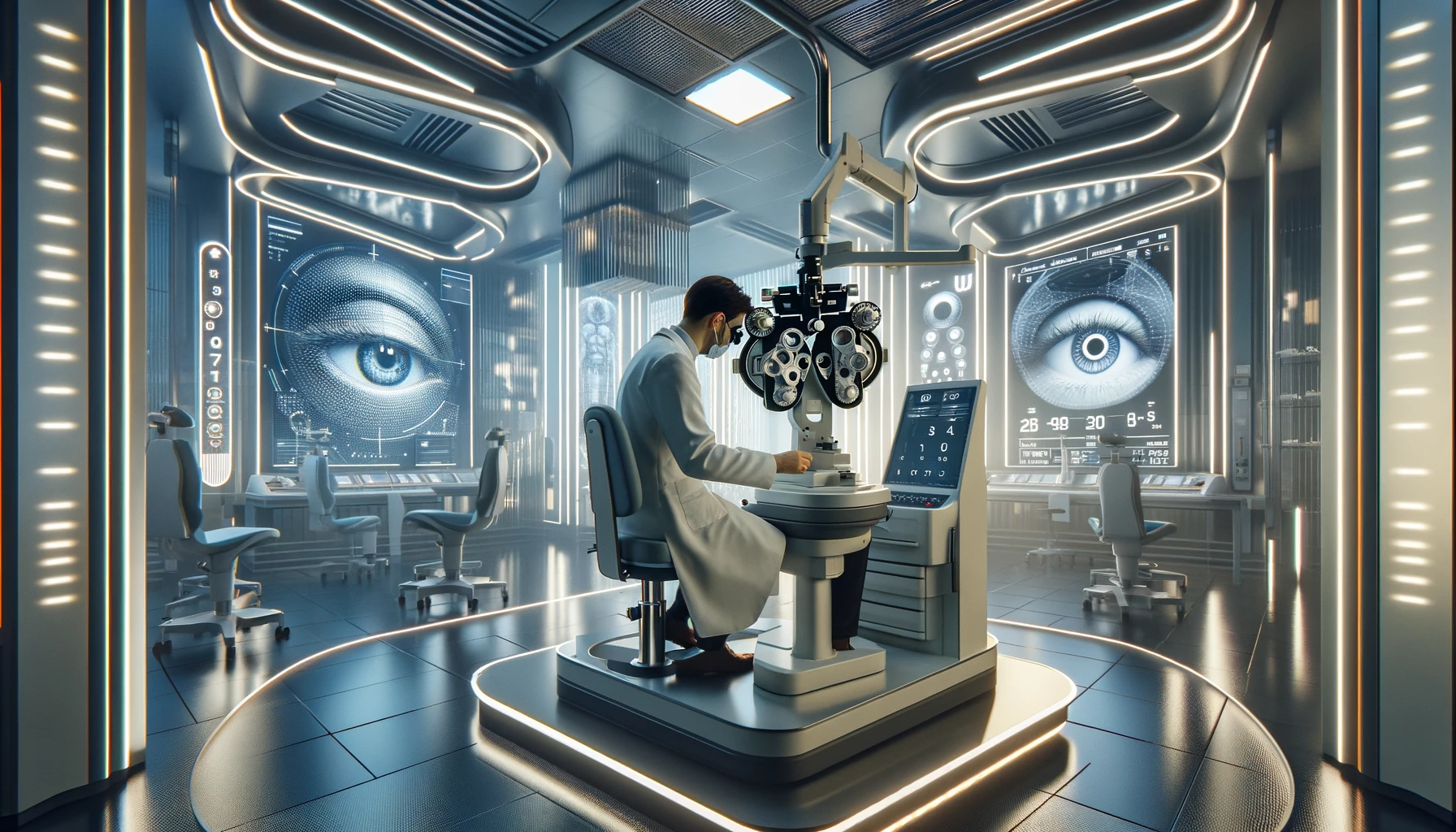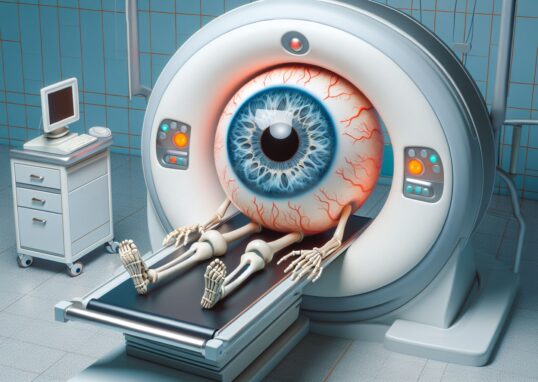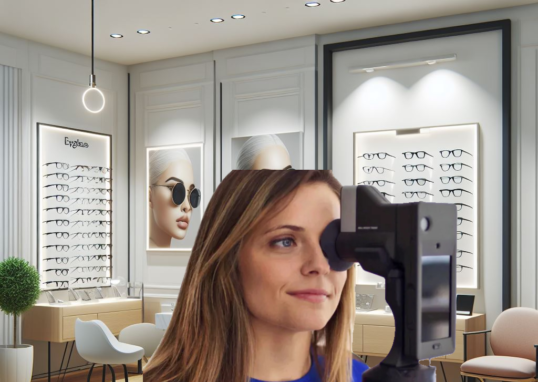
What are Smart Autorefractors?
Smart autorefractors represent a significant leap forward in the world of eye examinations. These devices, which blend traditional refractive measurement techniques with cutting-edge technology, are designed to assess how well your eyes focus light. In simpler terms, they help eye care professionals determine the right prescription for your glasses or contact lenses. But what sets smart autorefractors apart from their traditional counterparts? Let’s delve into their workings, technology, and unique features.
How Smart Autorefractors Work
At their core, smart autorefractors utilize advanced optical technology to measure the eye’s refractive error—essentially how much correction your vision needs to see clearly. These devices make use of sophisticated methods like wavefront aberrometry, which involves analyzing how light waves travel through the eye. This technology enables smart autorefractors to map the eye with incredible precision, identifying not just simple vision problems like nearsightedness or farsightedness, but also more complex issues that traditional devices might miss.
Key Technological Principles
One of the key technological principles behind smart autorefractors is automation. These devices are designed to be as autonomous as possible, requiring minimal input from the operator. This not only speeds up the examination process but also reduces the potential for human error, ensuring more accurate and consistent results. Furthermore, many smart autorefractors are equipped with user-friendly interfaces, making them easier to operate and less intimidating for patients.
Features That Set Them Apart
Several features distinguish smart autorefractors from traditional models. One notable feature is their enhanced accuracy. By leveraging advanced algorithms and optical technologies, smart autorefractors can provide more precise measurements of refractive errors. Another significant advantage is their efficiency; these devices can complete assessments quickly, minimizing the time patients spend in the examination chair.
Moreover, smart autorefractors often include design enhancements aimed at improving the patient experience. For example, some models feature an open view channel, allowing patients to feel more at ease during the exam by avoiding the claustrophobic feeling that can come with traditional devices. Additionally, the automation and self-guidance features present in smart autorefractors reduce the need for extensive operator training, making them accessible to a broader range of healthcare settings.
In conclusion, smart autorefractors mark a new era in eye care, offering unparalleled accuracy, efficiency, and user-friendliness. By incorporating cutting-edge technology and design, these devices not only enhance the quality of eye examinations but also promise to revolutionize the way we approach vision correction and eye health.
Advances in Smart Autorefractor Technology
The technology behind smart autorefractors is rapidly evolving, bringing new levels of precision and efficiency to eye care. These advancements are not just about refining the accuracy of prescriptions; they’re also making eye exams quicker, more comfortable, and more accessible to patients. Let’s explore some of the key technological leaps in this area and how they’re shaping the future of eye examinations.
Breakthrough Models and Features
As technology advances, so do the features of smart autorefractors. New models on the market now offer a range of capabilities that were hard to imagine a few years ago. For example, some devices use highly sophisticated sensors and algorithms to measure refractive errors in a matter of seconds. This speed does not compromise accuracy; in fact, it often enhances it by reducing the margin of error associated with patient fatigue or movement.
Another notable feature in some of the latest smart autorefractors is the ability to perform comprehensive wavefront analysis. This goes beyond traditional refractive error measurements, offering a detailed map of the eye’s optical system. Such detailed analysis can help detect aberrations that might not be evident with standard exams, leading to more personalized and effective vision correction solutions.
Connectivity and integration are also key areas of advancement. Many smart autorefractors now come with the ability to seamlessly integrate with other diagnostic tools and electronic health records (EHRs). This connectivity ensures that patient data is easily accessible, facilitating a more holistic approach to eye care and streamlining the workflow in clinical settings.
Impact on Patient Care and Diagnostics
The advancements in smart autorefractor technology have a direct impact on the quality of patient care. The precision and efficiency of these devices mean that eye care professionals can offer more accurate diagnoses and tailored treatment plans. Patients benefit from quicker exams and less waiting time, improving the overall experience and satisfaction.
Furthermore, the enhanced diagnostic capabilities of these devices allow for the early detection of a broader range of eye health issues. This early detection is crucial for managing conditions that, if left untreated, could lead to significant vision loss. By identifying such issues at an earlier stage, smart autorefractors play a vital role in preventive eye care.
In summary, the advances in smart autorefractor technology are transforming eye examinations, making them more accurate, efficient, and patient-friendly. These technological leaps not only improve the immediate experience of getting an eye exam but also contribute to better long-term eye health outcomes for patients. As technology continues to evolve, we can expect further innovations that will continue to push the boundaries of what’s possible in eye care diagnostics.
Leading Companies in the Smart Autorefractor Market
The market for smart autorefractors is competitive, with several companies leading the way in innovation and technology. These companies are not just manufacturers; they’re pioneers, pushing the boundaries of what’s possible in eye care diagnostics. Let’s take a closer look at some of the key players in the industry and the standout features of their smart autorefractor products.
Key Companies and Their Flagship Products
1. Zeiss: A well-known name in optics and optoelectronics, Zeiss offers a range of smart autorefractors known for their precision and reliability. Their devices often incorporate advanced technologies such as wavefront analysis, providing detailed insights into the eye’s refractive errors.
2. Topcon: Topcon specializes in medical devices and software solutions, with smart autorefractors that are celebrated for their accuracy and ease of use. Their products typically feature cutting-edge optical technology and integration capabilities with other diagnostic tools.
3. Nidek: Renowned for their innovative approach to eye care, Nidek’s smart autorefractors are designed with both patient comfort and diagnostic precision in mind. They often include features that allow for quick, non-invasive measurements, making the eye exam process smoother for patients.
4. Essilor: As a major player in the optical industry, Essilor offers smart autorefractors that emphasize user-friendly interfaces and high accuracy. Their devices are designed to streamline the refraction process, making it easier for eye care professionals to deliver top-quality care.
Unique Selling Points
Each of these companies brings something unique to the table, whether it’s Zeiss’s focus on advanced optical technology, Topcon’s emphasis on ease of integration, Nidek’s commitment to patient comfort, or Essilor’s dedication to user-friendly designs. What sets these companies apart is not just the quality of their smart autorefractors but also their commitment to ongoing innovation and improvement.
Market Trends
The competition among these leading companies fosters a dynamic market environment, driving continuous advancements in smart autorefractor technology. One notable trend is the increasing focus on connectivity and digital integration, enabling smoother workflows and better data management within eye care practices. Another trend is the development of more compact and portable devices, expanding access to high-quality eye exams in diverse settings, including remote and underserved areas.
In conclusion, the leading companies in the smart autorefractor market are at the forefront of technological innovation in eye care. Their flagship products not only offer unparalleled accuracy and efficiency but also reflect a broader commitment to improving patient care and expanding access to quality eye health services. As these companies continue to innovate, the future of eye diagnostics looks bright, with smart autorefractors playing a key role in shaping that future.
Advantages of Using Smart Autorefractors
Smart autorefractors have revolutionized eye care with their advanced technology, offering a host of benefits for both patients and eye care professionals. These devices streamline the process of determining the correct prescription for eyeglasses or contact lenses, making eye exams more efficient, accurate, and comfortable. Here, we explore the key advantages of using smart autorefractors in eye care.
Improved Diagnostic Precision
One of the most significant benefits of smart autorefractors is their ability to provide highly accurate measurements of the eye’s refractive error. Thanks to advanced technologies like wavefront aberrometry, these devices can detect even minor aberrations that might be overlooked by traditional methods. This precision is crucial for crafting effective vision correction solutions, ensuring patients receive the most appropriate prescriptions for their needs.
Enhanced Patient Experience
Smart autorefractors are designed with the patient’s comfort in mind. Many models feature a more open design, reducing the feeling of confinement during the exam. The quick and non-invasive nature of the tests, coupled with automated features, means that patients spend less time in the examination chair, leading to a more pleasant and less stressful experience overall.
Efficiency and Time-Saving
The automation and advanced features of smart autorefractors make eye exams faster than ever. This efficiency benefits both patients, who appreciate shorter visit times, and eye care professionals, who can see more patients in a day without sacrificing the quality of care. Faster exams also mean reduced fatigue for both parties, contributing to the overall accuracy of the diagnosis.
Minimization of Human Error
The automated capabilities of smart autorefractors reduce the likelihood of operator error, a common issue with more manual diagnostic tools. By standardizing the exam process and relying on sophisticated algorithms to analyze the data, these devices help ensure consistent and reliable results across different users and patients.
Potential for Telemedicine and Remote Diagnostics
Smart autorefractors are paving the way for innovations in telemedicine and remote eye care services. With their advanced connectivity features, these devices can transmit data to eye care professionals in real-time, making it possible to conduct comprehensive eye exams even in remote or underserved areas. This capability is crucial for expanding access to quality eye care, especially in regions where traditional eye care services may be limited.
In summary, the use of smart autorefractors in eye care offers a multitude of advantages, from improving the accuracy of diagnoses to enhancing the patient experience and enabling efficient, remote diagnostics. As technology continues to evolve, these devices will undoubtedly play an increasingly vital role in advancing the field of ophthalmology and optometry, making high-quality eye care more accessible to all.
Considerations and Limitations
While smart autorefractors bring many advancements to eye care, it’s important to acknowledge that they also come with certain considerations and limitations. These aspects are essential for both eye care professionals and patients to understand, ensuring realistic expectations and optimal use of the technology. Let’s explore some of the challenges and limitations associated with smart autorefractors.
Cost and Accessibility
One of the primary considerations when it comes to smart autorefractors is their cost. These advanced devices are typically more expensive than traditional autorefractors due to their sophisticated technology and features. This higher cost can make them less accessible to smaller clinics or practices with limited budgets, potentially limiting their widespread adoption.
Additionally, the cost factor can also impact patients, especially in regions where access to affordable eye care is already a challenge. While the benefits of using smart autorefractors are clear, their higher price point may restrict their availability to only certain segments of the population.
Learning Curve and Training
Despite their automated features and user-friendly design, there is still a learning curve associated with operating smart autorefractors. Eye care professionals may need to undergo specific training to fully utilize all the features and capabilities of these devices. This training can represent an additional time investment, which might be a barrier for some practices, especially those with high patient volumes or limited staffing.
Suitability for All Patients
While smart autorefractors are designed to be more comfortable and less invasive, there may still be cases where they are not suitable for all patients. For example, individuals with certain eye conditions, such as severe corneal irregularities or those who have difficulty sitting still during an exam, may not get accurate results from a smart autorefractor. In such cases, alternative diagnostic tools or methods may need to be employed.
Maintenance and Calibration
Like any sophisticated medical equipment, smart autorefractors require regular maintenance and calibration to ensure they continue to operate accurately. This necessity can add to the overall cost of ownership and may require practices to have access to specialized technical support. Failure to maintain and calibrate these devices properly can lead to inaccurate measurements and potentially impact patient care.
In conclusion, while smart autorefractors offer numerous advantages in terms of accuracy, efficiency, and patient experience, it’s important to consider their cost, the need for training, their suitability for all patients, and maintenance requirements. Understanding these limitations and considerations will help eye care professionals make informed decisions about incorporating smart autorefractors into their practice and ensure they are used in the most effective way possible.
Comparison with Traditional Refraction Methods
In the realm of eye care, the arrival of smart autorefractors marks a significant advancement over traditional refraction methods. While these modern devices offer a host of benefits, understanding how they stack up against conventional techniques is crucial for both patients and eye care professionals. This comparison sheds light on the efficiency, accuracy, patient experience, and cost-effectiveness of smart autorefractors versus traditional equipment.
Efficiency and Speed
Traditional refraction methods, which often involve a manual phoropter and require the patient to provide feedback on lens choices, can be time-consuming. In contrast, smart autorefractors automate much of this process, significantly reducing the time needed for an eye exam. This efficiency not only improves the workflow for eye care professionals but also enhances the patient experience by shortening the duration of the exam.
Accuracy and Precision
Smart autorefractors leverage advanced technologies, such as wavefront aberrometry, to measure the eye’s refractive error with high precision. This capability allows for a more detailed assessment of vision problems compared to traditional methods, which might not detect subtle aberrations. The increased accuracy of smart autorefractors can lead to more effective vision correction solutions for patients.
Patient Experience
The use of smart autorefractors generally results in a more comfortable and less intimidating experience for patients. Unlike traditional methods, which require the patient’s active participation and decision-making (“Which is better, one or two?”), smart autorefractors minimize the need for patient input, reducing stress and potential confusion. Moreover, the quicker and less invasive nature of exams with smart autorefractors can be particularly beneficial for children, elderly patients, or those with disabilities.
Cost-Effectiveness
While the initial investment in a smart autorefractor may be higher than traditional refraction equipment, the long-term benefits can outweigh these upfront costs. The efficiency and accuracy of smart autorefractors can lead to more reliable diagnoses, potentially reducing the need for follow-up visits and adjustments. However, the cost factor may still be a barrier for some practices, especially smaller or less financially secure ones, affecting the overall accessibility of this technology.
Case Studies and Examples
Illustrating the practical advantages and disadvantages of smart autorefractors versus traditional methods through case studies can provide valuable insights. For instance, a practice that switched to smart autorefractors might share data on reduced exam times and improved patient satisfaction rates. Conversely, a practice that found the cost of transitioning to be prohibitive could offer a perspective on the challenges of adopting new technology.
In summary, while smart autorefractors represent a significant technological leap forward in terms of efficiency, accuracy, and patient comfort, it’s essential to weigh these benefits against the costs and practical considerations of transitioning from traditional refraction methods. By carefully evaluating these factors, eye care professionals can make informed decisions that best meet the needs of their patients and practices.




